 There’s been much talk about the UK’s economic recovery and whether or not it has begun and whether consumer spending is actually the cause. The latest sector to post positive figures is the car industry, which has seen 2013 bring in the highest level of car sales since the onset of the credit crunch.
There’s been much talk about the UK’s economic recovery and whether or not it has begun and whether consumer spending is actually the cause. The latest sector to post positive figures is the car industry, which has seen 2013 bring in the highest level of car sales since the onset of the credit crunch.
According to the Society of Motor Manufacturers and Traders (SMMT), vehicle registrations in 2013 were 2.26 million, which represented a 10.8% increase from 2012. That’s not to say that we have returned to the heights seen pre-crisis levels, as sales still remain some way below their 2007 figure, but the data is certainly moving in the right direction. The key questions are: What’s the cause of this growth and what does it mean for the UK economy?
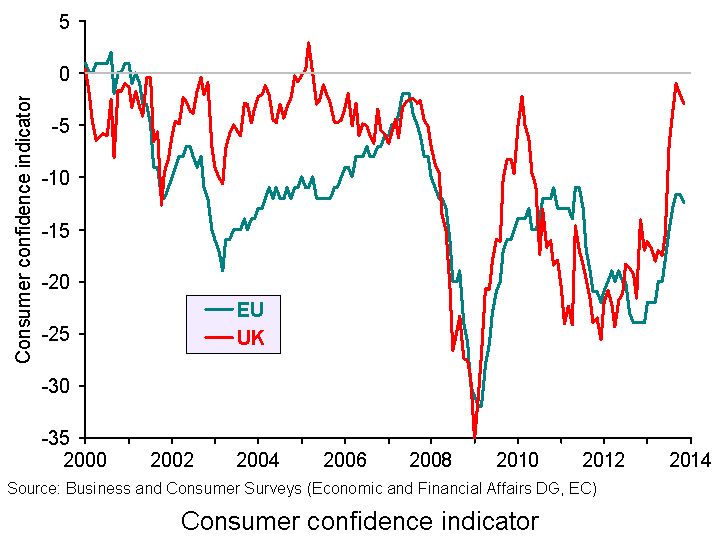 The economy has certainly turned a corner and perhaps consumer confidence is improving to reflect this. With consumes more optimistic about future economic prospects, more luxury items may well be purchased. During the height of the recession, many families may well have said ‘it will last’ or ‘we’ll make do’, referring to their old cars. However, this improved confidence, together with attractive finance deals may have been instrumental in convincing consumers to splash out. This is reflected in the data, which indicates that some 75% of car sales involve a finance package. One further explanation that has been offered by industry analysts is that the refunds individuals are receiving through mis-sold payment protection insurance are providing a nice contribution towards the deposit.
The economy has certainly turned a corner and perhaps consumer confidence is improving to reflect this. With consumes more optimistic about future economic prospects, more luxury items may well be purchased. During the height of the recession, many families may well have said ‘it will last’ or ‘we’ll make do’, referring to their old cars. However, this improved confidence, together with attractive finance deals may have been instrumental in convincing consumers to splash out. This is reflected in the data, which indicates that some 75% of car sales involve a finance package. One further explanation that has been offered by industry analysts is that the refunds individuals are receiving through mis-sold payment protection insurance are providing a nice contribution towards the deposit.
PPI payments will certainly dry up, but as long as attractive finance packages remain, car sales should continue. A key factor affecting affordability may be interest rates. When they increase, any variable rate loans will become more expensive to service and this may act to deter consumers. However, if the car industry helps to stimulate other sectors and wages begin to increase, the overall effect may be to sustain and even further the growth of this key economic sector. The following articles consider the car industry.
UK car sales hit five-year high The Guardian, Angela Monaghan (7/1/14)
UK new car sales highest since 2007, SMTT says BBC News (7/1/14)
Car sales increased by almost 11% in 2013 Sky News (7/1/14)
UK new car sales rise to highest level since 2007 Reuters, David Milliken (7/1/14)
UK car sales up 11% in 2013, topping pre-crisis levels Wall Street Journal, Matthew Curtin and Ian Walker (7/1/14)
New car sales in UK at highest since before recession Independent, Sean O’Grady (7/1/14)
UK car sales top pre-recession levels Financial Times, Henry Foy (6/1/14)
Questions
- How important is the car industry in the context of the UK economy?
- How is the UK car industry performing relative to its Western rivals?
- Would a 30% single rate of income tax be equitable?
- Explain the way in which car sales have been affected by consumer confidence.
- How have finance packages helped to stimulate car sales?
- What are the key macroeconomic variables that are likely to affect the future performance of this key sector?
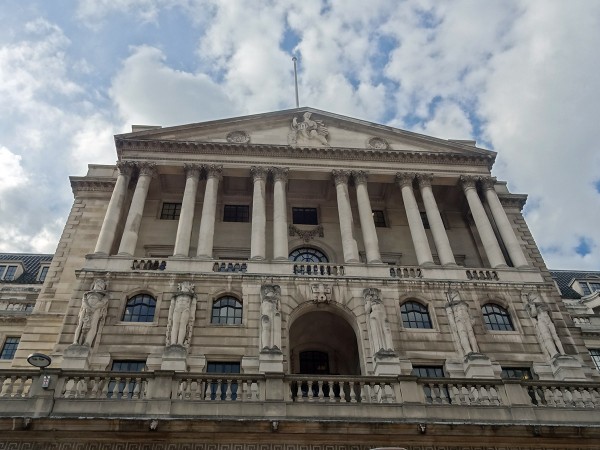 Interest rates in the UK have been at 0.5% since mid-2009, when they were reduced with the objective of stimulating the economy, through encouraging consumption and investment. Over the past 12 months, economic recovery has begun and with the housing market rising by 8.4% over the past year, what can we expect from interest rates?
Interest rates in the UK have been at 0.5% since mid-2009, when they were reduced with the objective of stimulating the economy, through encouraging consumption and investment. Over the past 12 months, economic recovery has begun and with the housing market rising by 8.4% over the past year, what can we expect from interest rates?
Interest rates are a powerful tool of monetary policy and affect many of the components of aggregate demand. As such, they are also a key tool in achieving low and stable inflation rates and keeping unemployment low. Unemployment has been falling, as the economic recovery has taken hold, but is still above the 7% level that the Bank of England has said is needed before rates are increased. However, with the improvements in the housing market, some are now expecting interest rates to go up sooner than previously thought. (Click here for a PowerPoint of the chart.)
some are now expecting interest rates to go up sooner than previously thought. (Click here for a PowerPoint of the chart.)
28 economists were questioned about the future of interest rates in the UK and 93% of those asked were of the opinion that interest rates will still be at 0.5% by the end of 2014. Furthermore, more than 50% think that interest rates will not begin to go up until the second half of 2015 and 15% suggest that they will not increase until 2016.
What happens to interest rates will depend on many things, including changes in productivity, unemployment trends, wage growth and inflation. It is also likely to depend on economic changes in countries around the world. The following articles consider the future of interest rates.
UK interest rates to stay at 0.5% in 2014 – economists BBC News (3/1/14)
It is high time we raised interest rates and returned to normality The Telegraph, Jeremy Warner (2/1/14)
BoE will ‘move goalposts’ on interest rates Financial Times, Chris Giles and Claire Jones (1/1/14)
Interest rate rise with no wage increase ‘will push heavily-indebted to edge’ The Guardian, Heather Stewart (2/12/14)
BoE may lower jobless rate guidance, but not this month – Reuters poll Reuters, Suzanne Plunkett (3/1/14)
Questions
- Explain how each component of aggregate demand will be affected by changes in interest rates.
- How do interest rates affect unemployment?
- Interest rates are used to keep inflation on target. Explain how this is done.
- What might be the effect on the macroeconomic objectives if interest rates are increased?
- What are the arguments (a) for increasing Bank rate and (b) for maintaining it at the current 0.5% level?
 As the old year gives way to the new, papers have been full of economic forecasts for the coming year. This year is no exception. The authors of the articles below give their predictions of what is to come for the global economy and, for the most part, their forecasts are relatively optimistic – but not entirely so. Despite a sunny outlook, there are various dark clouds on the horizon.
As the old year gives way to the new, papers have been full of economic forecasts for the coming year. This year is no exception. The authors of the articles below give their predictions of what is to come for the global economy and, for the most part, their forecasts are relatively optimistic – but not entirely so. Despite a sunny outlook, there are various dark clouds on the horizon.
Most forecasters predict a higher rate of global economic growth in 2014 than in 2013 – and higher still in 2015. The IMF, in its October forecasts, predicted global growth of 3.6% in 2014 (up from 2.9% in 2013) and 4.0% in 2015.
Some countries will do much better than others, however. The USA, the UK, Germany and certain developing countries are forecast to grow more strongly. The eurozone as a whole, however, is likely to see little in the way of growth, as countries such as Greece, Spain, Portugal and Italy continue with austerity policies in an attempt to reduce their debt. 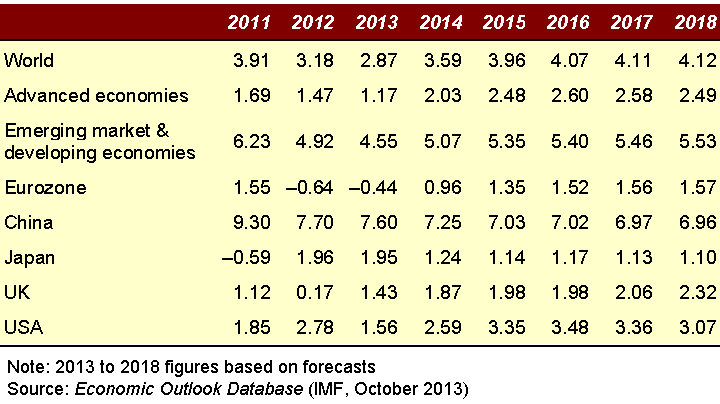 Chinese growth has slowed, as the government seeks to rebalance the economy away from exports and investment in manufacturing towards consumption, and services in particular. It is still forecast to be 7.3% in 2014, however – well above the global average. Japanese growth has picked up in response to the three arrows of fiscal, monetary and supply-side policy. But this could well fade somewhat as the stimulus slows. The table shows IMF growth forecasts for selected countries and groups of countries to 2018.
Chinese growth has slowed, as the government seeks to rebalance the economy away from exports and investment in manufacturing towards consumption, and services in particular. It is still forecast to be 7.3% in 2014, however – well above the global average. Japanese growth has picked up in response to the three arrows of fiscal, monetary and supply-side policy. But this could well fade somewhat as the stimulus slows. The table shows IMF growth forecasts for selected countries and groups of countries to 2018.
Much will depend on what happens to monetary policy around the world. How quickly will monetary stimulus taper in the USA and in Japan? Will the ECB introduce more aggressively expansionary monetary policy? When will the Bank of England start raising interest rates?
Growth within countries is generally favouring those on higher incomes, with the gap between rich and poor set to continue widening over the coming years. The pay of top earners has continued to rise considerably faster than prices, while increasingly flexible labour markets and squeezed welfare budgets have seen a fall in living standards of many on low incomes. According to a Which? survey (reported in the Independent article below), in the UK:
Only three in ten expect their family’s situation to improve in the new year, while 60% said they are already dreading the arrival of their winter energy bill. The Which? survey also found that 13 million people could afford to pay for Christmas only by borrowing, with more than four in ten using credit cards, loans or overdrafts to fund their festive spending. A third of people (34%) also dipped into their savings, taking an average of £450 from their accounts.
If recovery is based on borrowing, with real incomes falling, or rising only very slowly, household debt levels are likely to increase. This has been stoked in the UK by the ‘Help to Buy‘ scheme, which has encouraged people to take on more debt and has fuelled the current house price boom. This could prove damaging in the long term, as any decline in confidence could lead to a fall in consumer expenditure once more as people seek to reduce their debts.
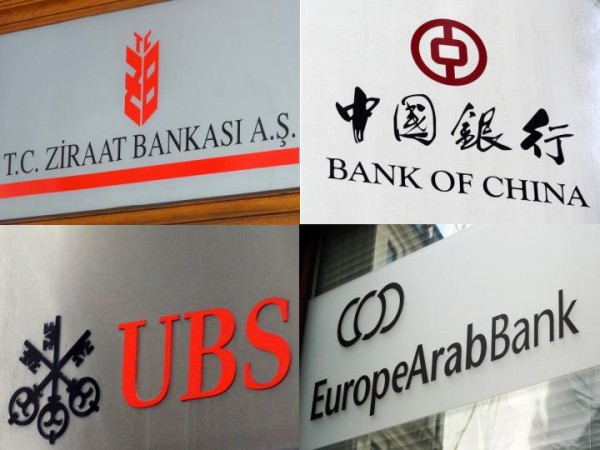 And what of the global banking system? Is it now sufficiently robust to weather a new crisis. Is borrowing growing too rapidly? Is bank lending becoming more reckless again? Are banks still too big to fail? Is China’s banking system sufficiently robust? These are questions considered in the articles below and, in particular, in the New York Times article by Gordon Brown, the former Prime Minister and Chancellor of the Exchequer.
And what of the global banking system? Is it now sufficiently robust to weather a new crisis. Is borrowing growing too rapidly? Is bank lending becoming more reckless again? Are banks still too big to fail? Is China’s banking system sufficiently robust? These are questions considered in the articles below and, in particular, in the New York Times article by Gordon Brown, the former Prime Minister and Chancellor of the Exchequer.
Articles
Global economy: hopes and fears for 2014The Observer, Heather Stewart and Larry Elliott (29/12/13)
Looking ahead to 2014 BBC News, Linda Yueh (20/12/13)
Low hopes for a happy new financial year in 2014 Independent, Paul Gallagher (29/12/13)
Brisk UK economic growth seen in 2014 fuelled by spending – Reuters poll Reuters, Andy Bruce (12/12/13)
GLobal Economy: 2014 promises faster growth, but no leap forward Reuters, Andy Bruce (29/12/13)
My 2014 Economic Briefing Huffington Post, Tony Dolphin (27/12/13)
Three UK Economy Stories that will Dominate in 2014 International Business Times, Shane Croucher (27/12/13)
Who You Calling a BRIC? Bloomberg, Jim O’Neill (12/11/13)
Hope and Hurdles in 2014 Project Syndicate, Pingfan Hong (27/12/13)
On top of the world again The Economist (18/11/13)
Digging deeper The Economist (31/10/13)
BCC Economic Forecast: growth is gathering momentum, but recovery is not secure British Chambers of Commerce (12/13)
Eight predictions for 2014 Market Watch, David Marsh (30/12/13)
Stumbling Toward the Next Crash New York Times, Gordon Brown (18/12/13)
Central banks must show leadership to rejuvenate global economy The Guardian, Larry Elliott (1/1/14)
Global economy set to grow faster in 2014, with less risk of sudden shocks The Guardian, Nouriel Roubini (31/12/13)
A dismal new year for the global economy The Guardian, Joseph Stiglitz (8/1/14)
Forecasts and reports
World Economic Outlook (WEO) IMF (October 2013)
Economic Outlook OECD (November 2013)
Output, prices and jobs The Economist
Bank of England Inflation Report: Overview Bank of England (November 2013)
Questions
- What reasons are there to be cheerful about the global economic prospects for 2014 and 2015?
- Who will gain the most from economic growth in the UK and why?
- Why is the eurozone likely to grow so slowly, if at all?
- Are we stumbling towards another banking crisis, and if so, which can be done about it?
- Why has unemployment fallen in the UK despite falling living standards for most people?
- What is meant by ‘hysteresis’ in the context of unemployment? Is there a problem of hysteresis at the current time and, if so, what can be done about it?
- Explain whether the MINT economies are likely to be a major source of global economic growth in the coming year?
- Why is it so difficult to forecast the rate of economic growth over the next 12 months, let alone over a longer time period?
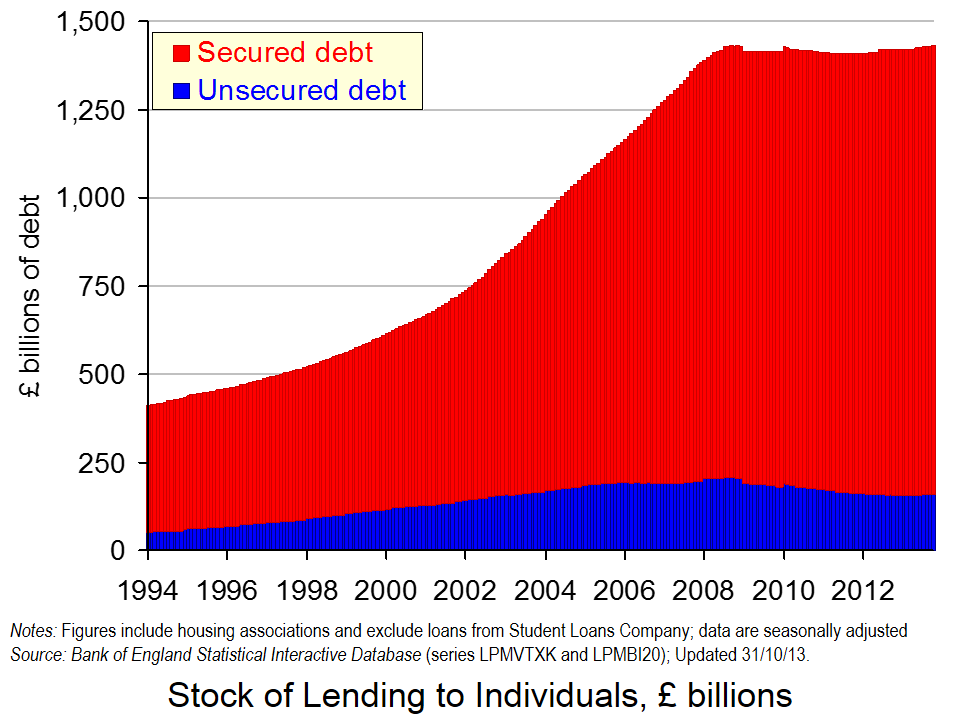 As of 31 October 2013, British households had a stock of debt close to £1.43 trillion. Economists are increasingly recognising that the financial well-being of economic agents is an important macroeconomic issue. The financial position of households, businesses and governments can be expected to affect behaviour and, hence, economic activity.
As of 31 October 2013, British households had a stock of debt close to £1.43 trillion. Economists are increasingly recognising that the financial well-being of economic agents is an important macroeconomic issue. The financial position of households, businesses and governments can be expected to affect behaviour and, hence, economic activity.
We can calculate the net financial wealth of households as the difference between their stock of financial assets (savings) and their financial liabilities (debt). The latest figures from the Bank of England’s Money and Credit show that as of Halloween 2013, British households had amassed a stock of debt of £1.4296 trillion. It is certainly a large figure since it not far short of the expected GDP figure for 2013 of around £1.6 trillion.
The chart above helps to show that of the aggregate household debt, £1.271 trillion is secured debt (debt secured against property). The remaining stock of £158.589 billion is unsecured debt (e.g. overdrafts, outstanding credit card debt and personal loans). In short, 89 per cent of the stock of outstanding household debt is mortgage debt. (Click here to download a PowerPoint of the chart.)
In January 1994 the stock of secured debt stood at £358.75 billion and the stock of unsecured debt at £53.773 billion. 87 per cent of debt then was secured debt and, hence, little different to today. The total stock of debt has grown by 247 per cent between January 1994 and October 2013. Unsecured debt has grown by 199 per cent while secured debt has grown by 254 per cent.
But, consider now the path of debt between the end of October 2008 and October 2013. During this period, the monthly series of the stock of unsecured debt has fallen on 52 occasions and risen on only 9 occasions. In contrast, the stock of secured debt has fallen on only 10 occasions and often by very small amounts. Consequently, the stock of unsecured debt has fallen by 22.8 per cent between the end of October 2008 and October 2013. In contrast, the stock of secured debt has risen by 3.9 per cent. The total stock of debt has risen by 0.1 per cent over this period and, therefore, it is essentially unchanged.
The amount of debt accumulated by households is example of the increasing importance of the financial system in our everyday lives. The term financialisation helps to capture this. Financialisation means that economists need to think much more about how financial institutions and the financial well-being of people, businesses and governments affect economic activity. There is little doubt that the financial position or financial health of economic agents, such as households, affects their behaviour. We would expect in the case of households for their financial well-being to exert an influence on their propensities to spending or save. But, just how is an area in need of much, much more research.
Articles
UK household debt hits record high BBC News (29/11/13)
Average household debt ‘doubled in last decade’ Telegraph, Edward Malnick (20/11/13)
£1,430,000,000,000 (that’s £1.43 trillion): Britain’s personal debt timebomb Independent, Andrew Grice (20/11/13)
Data
Money and Credit – October 2013 Bank of England
Statistical Interactive Database Bank of England
Questions
- Outline the ways in which the financial system could impact on the spending behaviour of households.
- Why might the current level of income not always be the main determinant of a household’s spending?
- How might uncertainty affect spending and saving by households?
- Explain what you understand by net lending to individuals. How does net lending to individuals affect stocks of debt?
- Outline the main patterns seen in the stock of household debt over the past decade and discuss what you consider to be the principal reasons for these patterns.
- What factors might explain the rather different pattern seen in the growth of debt since October 2008 compared with that in earlier part of the 2000s?
- What do you understand by the term financialisation? Of what importance is this phenomenon to economic behaviour?
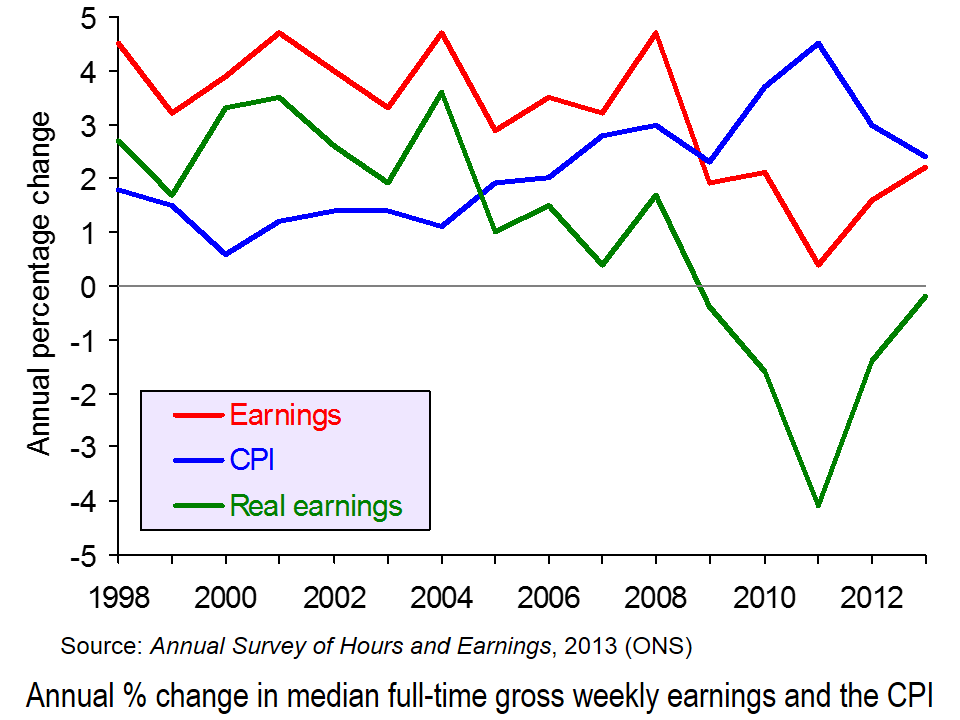 The ONS has just published two of its major annual publications on income and expenditure in the UK. The first is the Annual Survey of Hours and Earnings (ASHE) and looks at earnings from 1998 to 2013. The second is Family Spending and looks at the level and pattern of household spending each year from 2001 to 2012.
The ONS has just published two of its major annual publications on income and expenditure in the UK. The first is the Annual Survey of Hours and Earnings (ASHE) and looks at earnings from 1998 to 2013. The second is Family Spending and looks at the level and pattern of household spending each year from 2001 to 2012.
Figures from the two publications show that average real incomes have fallen each year since 2008. This is illustrated in the first chart (click here for a PowerPoint of the chart). They also show that household expenditure in real terms is falling and is at the lowest level since 2006.
Overall picture
In 2012, households’ average weekly disposable income was £597. In 2012 prices, this was down from £621 in 2010 (after the recession) and £659 in 2008 (before the recession).
Household expenditure is at its lowest level in real terms for over a decade. In 2012 households spent on average £489.00 per week. In 2012 prices, this compares with £521.90 in 2001/2 and £533.80 in 2006 (the peak year).
Picture for particular income groups and products
Although average real incomes have fallen, not everyone has been affected the same. For example, not all occupations have seen a fall in incomes (see the table at the end of the BBC article, Earnings rise slower than inflation for fifth year running). Also, as income distribution has become less equal, so those in lower income groups have seen their real incomes fall the fastest. This is partly the result of nominal wages rising less fast for low-paid workers and partly the result of price increases for various essentials, such as food and power being greater than the rate of inflation, and these products constituting a higher proportion of expenditure for poor people than rich people (see Squeezed Britain 2013).
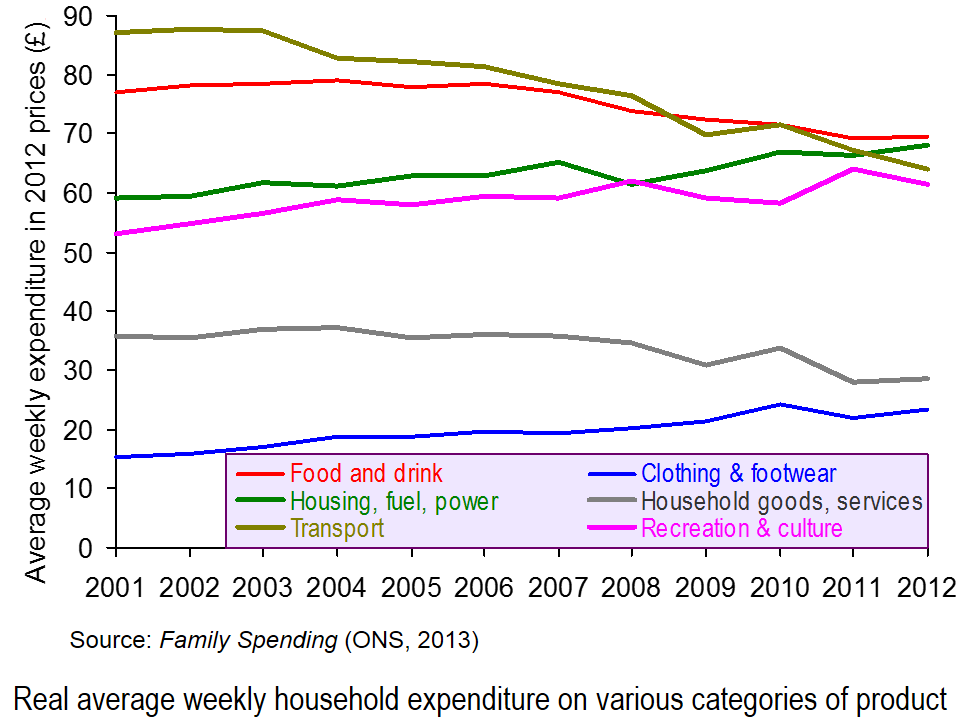 Likewise expenditure hasn’t fallen on all categories of product. Since 2006, real expenditure on clothing and footwear and on housing, fuel and power has risen. The second chart illustrates expenditure on some of the different categories and how the balance has changed (click here for a PowerPoint). This partly reflects the changes in prices of products, with some items, such as electricity, gas and rent having risen faster than the average, and with the demand for such items being relatively price inelastic.
Likewise expenditure hasn’t fallen on all categories of product. Since 2006, real expenditure on clothing and footwear and on housing, fuel and power has risen. The second chart illustrates expenditure on some of the different categories and how the balance has changed (click here for a PowerPoint). This partly reflects the changes in prices of products, with some items, such as electricity, gas and rent having risen faster than the average, and with the demand for such items being relatively price inelastic.
The changing pattern is also partly the result of different income elasticities of demand for different items. Thus, with falling real incomes, the proportion of income spent on products with a low income elasticity of demand is likely to rise.
 Expenditure also varies by income group. People on higher incomes tend to spend a greater proportion of their income on things such as leisure activities (e.g. eating out and holidays), motoring, and clothing and footwear. Poorer people tend to spend proportionately more on food and drink, and on electricity, gas and rent (even net of housing benefit). These differences are illustrated in the third chart which looks at certain categories of expenditure of three different disposable income groups: the poorest 10% (decile), the richest 10% and the 6th decile (i.e. the 6th group up from the bottom – the group with average or just above average income) (click here for a PowerPoint for the chart). Detailed figures can be found here, which is Table 3.2 from Family Spending.
Expenditure also varies by income group. People on higher incomes tend to spend a greater proportion of their income on things such as leisure activities (e.g. eating out and holidays), motoring, and clothing and footwear. Poorer people tend to spend proportionately more on food and drink, and on electricity, gas and rent (even net of housing benefit). These differences are illustrated in the third chart which looks at certain categories of expenditure of three different disposable income groups: the poorest 10% (decile), the richest 10% and the 6th decile (i.e. the 6th group up from the bottom – the group with average or just above average income) (click here for a PowerPoint for the chart). Detailed figures can be found here, which is Table 3.2 from Family Spending.
Just as the time-series data looking at changing income and expenditure over time can illustrate the different income elasticities of demand for different products, so can the cross-sectional data in Tables 3.1 and 3.2 of Family Spending.
Articles
Earnings rise slower than inflation for fifth year running BBC News (12/12/13)
Energy and rent are now the biggest family bills The Telegraph, Steve Hawkes (11/12/13)
Families spend £489 each week – on what? The Guardian, Mona Chalabi (11/12/13)
Cost of energy hits family budgets, says ONS BBC News (11/12/13)
Family spending interactive: how has it changed? The Guardian Datastore, Mona Chalabi (11/12/13)
Data
Annual Survey of Hours and Earnings, 2013 Provisional Results ONS (12/12/13)
Annual Survey of Hours and Earnings, 2013 Provisional Results: Statistical Bulletin ONS (12/12/13)
Family Spending, 2013 Edition ONS (11/12/13)
Family spending in 2012: Infographic ONS (11/12/13)
 Video Summary: Are you an average spender? ONS (11/12/13)
Video Summary: Are you an average spender? ONS (11/12/13)
Household expenditure based on COICOP classification, 2001-02 to 2012 at 2012 prices: Table 4.1 of Family Spending ONS (11/12/13)
Detailed household expenditure as a percentage of total expenditure by disposable income decile group, 2012: Table 3.2 of Family Spending ONS (11/12/13)
Questions
- What are the determinants of the price elasticity of demand for a product?
- What are the limitations of using time-series data of prices and expenditure to estimate the price elasticity of demand for particular products?
- What are the determinants of the income elasticity of demand for a product?
- What are the limitations of using time-series data of incomes and expenditure to estimate the income elasticity of demand for particular products?
- What are the limitations of using cross-sectional data of expenditure of different income groups to estimate the income elasticity of demand for particular products?
- How do your answers to the above questions demonstrate the significance of the ceteris paribus (other things being equal) assumption?
- If real earnings are falling, why are people able to spend more in real terms?
- What are the macroeconomic implications of increased consumer spending at a time of falling real incomes?
- How could increased consumer spending help to reverse the fall in real incomes (a) in the short run (b) over a period of a few years? Distinguish between the effects on aggregate demand and aggregate supply.
 There’s been much talk about the UK’s economic recovery and whether or not it has begun and whether consumer spending is actually the cause. The latest sector to post positive figures is the car industry, which has seen 2013 bring in the highest level of car sales since the onset of the credit crunch.
There’s been much talk about the UK’s economic recovery and whether or not it has begun and whether consumer spending is actually the cause. The latest sector to post positive figures is the car industry, which has seen 2013 bring in the highest level of car sales since the onset of the credit crunch. The economy has certainly turned a corner and perhaps consumer confidence is improving to reflect this. With consumes more optimistic about future economic prospects, more luxury items may well be purchased. During the height of the recession, many families may well have said ‘it will last’ or ‘we’ll make do’, referring to their old cars. However, this improved confidence, together with attractive finance deals may have been instrumental in convincing consumers to splash out. This is reflected in the data, which indicates that some 75% of car sales involve a finance package. One further explanation that has been offered by industry analysts is that the refunds individuals are receiving through mis-sold payment protection insurance are providing a nice contribution towards the deposit.
The economy has certainly turned a corner and perhaps consumer confidence is improving to reflect this. With consumes more optimistic about future economic prospects, more luxury items may well be purchased. During the height of the recession, many families may well have said ‘it will last’ or ‘we’ll make do’, referring to their old cars. However, this improved confidence, together with attractive finance deals may have been instrumental in convincing consumers to splash out. This is reflected in the data, which indicates that some 75% of car sales involve a finance package. One further explanation that has been offered by industry analysts is that the refunds individuals are receiving through mis-sold payment protection insurance are providing a nice contribution towards the deposit.








